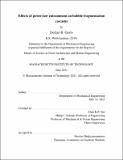| dc.description.abstract | This thesis considers the evolution of the bulk bubble-size distribution 𝑁(𝑎,𝑡) of large bubbles (Weber number 𝑊𝑒 >> 1) under free-surface entrainment described generally by an entrainment size distribution 𝐼(𝑎) with power-law slope 𝛾 and large-radius cutoff 𝑎ₘₐₓ. The focus is the interaction between turbulence-driven fragmentation and free-surface entrainment, and, for simplicity, other mechanisms such as degassing, coalescence, and dissolution are ignored. Of special interest is the equilibrium bulk bubble-size distribution [chemical formula], with local power-law slope [chemical formula], and the time scale 𝜏𝑐 to reach this equilibrium after initiation of entrainment. For bubbles with radii 𝑎 << aₘₐₓ, there are two regimes of [chemical formula] depending on 𝛾: a weak (𝛾 > −4) and a strong (𝛾 ≤ −4) injection regime where [chemical formula] and [chemical formula], respectively. The weak regime provides a general explanation for the commonly observed −10/3 power law originally proposed by Garrett et al. (J. Phys. Oceanogr., vol. 30 (9), 2000, pp. 2163–2171), and suggests that different weak entrainment mechanisms can all lead to this result. For [chemical formula] exhibits a steepening deviation from a power law due to fragmentation and entrainment, similar to what has been previously observed, but here absent other mechanisms such as degassing. The evolution of 𝑁(𝑎,𝑡) to [chemical formula] is characterized by the critical time [chemical formula], where 𝜀 is the turbulence dissipation rate and [chemical formula] is a new constant that quantifies the dependence on the size distribution of daughter bubbles created during fragmentation. For typical breaking waves, [chemical formula] can be quite small, limiting the time [chemical formula] when direct measurement of 𝑁(𝑎,𝑡) might provide information about the underlying entrainment size distribution. | |
